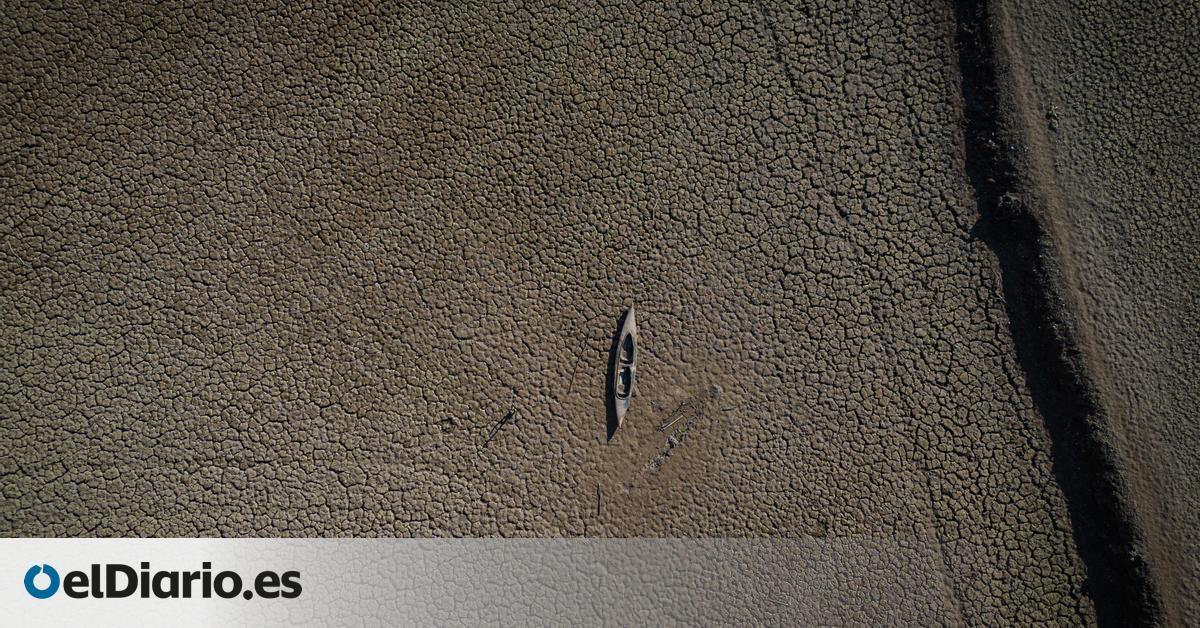
Catalonia has just declared an emergency due to the lack of water. Six million people face restrictions. In Andalusia, the measures due to shortages affect more than four million citizens. Both cases illustrate the reality that the climate crisis holds for Spain: there is less water to satisfy a demand that has become so intensive that it is increasingly difficult to meet.
Of course, the drought in Catalonia and Andalusia is marking historical milestones due to its severity. This is demonstrated by the fact that measures were also taken with few precedents. Both regional governments have activated restrictions of some kind for household taps, something extremely unusual because the Water Law makes it clear what the order of preference is when using it: the number one priority is “supply to the population.” . It is the last thing to touch when water resources are scarce.
“Heat waves and droughts are the two most important meteorological and climatic risks for southern Europe, including a good part of Spain, already today and, even more so, in the coming decades,” the professor reminded elDiario.es. of Physical Geography of the University of Barcelona, Javier Martín Vide, to explain how the risk of megadrought had grown on the continent.
Source: Copernicus Sentinel Data
In fact, the collapse in rainfall in 2023 was one of the ten most costly climate disasters of the year in the world, according to the annual analysis of the Christian Aid organization, which calculated a loss of 50 euros for each inhabitant due to the drought that In the month of April it was already strong.
“Drought is the acute manifestation of a chronic challenge,” recalls Gonzalo de la Cámara, coordinator of the Water Economy Department of the IMDEA Agua Foundation. “The decrease in rainfall is a very important temporary phenomenon and even more so with the scientific evidence that climate change makes droughts more frequent, intense and rapid. And, of course, this episode is very relevant, but it should not divert attention from what is chronic: the scarcity of water in the Mediterranean basins, in the Gulf of Cádiz, and the archipelagos.” Scarcity is the lack of resources to satisfy accepted demands.
At the beginning of February 2024, the reservoirs in the Internal Basins of Catalonia are at 15.75% of their capacity. Almost the entire demarcation is in a state of exceptionality, pre-emergency or emergency due to shortages.
In Andalusia, the Guadalquivir reservoirs contain 21% of its total. Virtually the entire district is in a state of emergency due to shortages. Those of Guadalete-Barbate store 14.6% and their territory is in severe or serious shortage, according to reports from the Junta de Andalucía.
In the Andalusian Mediterranean Basins they have 18.3% of the total. There, from Campo de Gibraltar to Granada, there is a serious shortage. In those of the Tinto-Odiel-Piedras district they reach 70%, but, even so, almost all of their systems present severe or serious shortages to meet consumption.
Source: Copernicus Sentinel Data
The most striking restrictions are those that impose limits on urban household consumption. In Catalonia the water supply will be reduced to 200 liters per inhabitant per day (the supply is the amount of water that is made available to the system). In some municipalities, the tap pressure is reduced, which causes less liquid to come out.
In Andalusia there are supply restrictions in almost all provinces. The pressure is lowered or the supply is cut off by time slots and human consumption has been prohibited due to the poor state of the water that remained in the squeezed reservoirs such as in the north of Córdoba or Almería.

Supply situation in Andalusia due to water shortage
D. H. Tinto
Odriel- Stones
DH Cuencas
Mediterranean
Measures against drought
UPDATE: JANUARY 16
GRAPHIC: IGNACIO SÁNCHEZ. SOURCE: AEOPAS

Supply situation in Andalusia
due to water shortage
D. H. Tinto
Odriel- Stones
DH Cuencas
Mediterranean
Measures against drought
UPDATE: JANUARY 16
GRAPHIC: IGNACIO SÁNCHEZ. SOURCE: AEOPAS
All in all, urban water consumption in Spain is, on average, 133 liters per person per day. 122 if you look at the metropolitan areas. “It is one of the best data at a European level and also very good at a global level,” explains De la Cámara.
The economist does not believe that “that is where the challenge lies. Although we have, out of responsibility, to convey a saving message at home, it is much more important to become aware that responsibility for water consumption goes far beyond turning on the tap and flushing the toilet but rather with our entire model. development or with our food system.” And he concludes: “It is very shocking” to restrict the supply to 80% of the population of Catalonia, “but it is a tiny part of water extractions. The crucial thing is to focus on the water resource in the territory where the great pending challenge is going to be agriculture.”
Source: Copernicus Sentinel Data
The professor of Human Geography at the University of Seville, Leandro Moral, sees “parallelisms” between Catalonia and Andalusia in “a drought superimposed on overexploitation, with climate change hovering overhead.” But also differences: “In Andalusia there is a diversity of diverse basins, often uncoordinated and without unity of criteria.”
The researcher adds that in Catalonia they have a more solid drought plan compared to “very recent and undeveloped” planning in Andalusia’s own basins. And he does not miss that “more than half of the Andalusian territory is managed by the Guadalquivir Confederation of the Ministry of Ecological Transition and that sometimes creates tensions between administrations with the Board.”
In these times of drought and scarcity, supply cuts to irrigation have also been in place for some time. Up to 50% in Tinto-Odiel-Piedras, or 88% in Guadalquivir, both in an agricultural powerhouse such as Andalusia.
Source: Copernicus Sentinel Data
But the problem comes from the intensive and sustained consumption of water in times of normality that squeeze the reserves season after season. A review by the European Commission by river basins warned that the water exploitation index (WEI+) of the Guadalquivir was 45% while in the Guadalete-Barbate basin it was above 20%. Other calculations for the Mediterranean Basins placed that WEI+ at more than 50%.
If this index – which measures the total annual extraction of fresh water with respect to the long-term annual average of available water – is above 20%, it is considered that there is water stress and the conditions for scarcity are met, according to the European Agency. enviroment. If it is beyond 40% “it indicates that the stress is severe and water use is unsustainable.”
The most recent hydrological plans admit that, for example, in the Guadalquivir demarcation there is a gap between endowments and resources of 200 hm3. In the Mediterranean basins it reaches 183 hm3.
And in these conditions, when the lack of rain arrives, they aggravate the situation in an already stressed system. As the expert Nuria Hernández Mora indicates: “There is no margin. And the best management of drought is done by applying prudence in times of normality.” “However, the current situation is even more serious than anticipated by those of us who have been warning for years,” says Leandro Moral.
Source: www.eldiario.es

